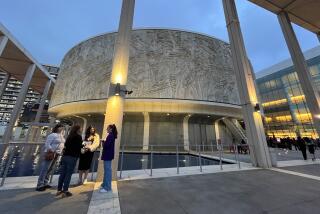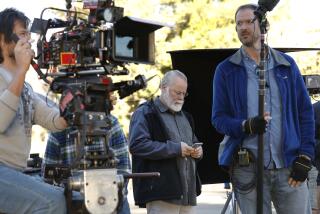After All the Promises, Business Goes Unfinished
LAGUNA BEACH — As the year draws to a close, two of the county’s major theatrical institutions--the oldest and the youngest--are facing a common affliction: broken promises and unfinished business.
The 70-year-old Laguna Playhouse, which produces an amateur season at the Moulton Theatre, has virtually given up on its plans to purchase the vacant General Telephone Building on Mermaid Street, where it had expected to establish a second, smaller theater for a professional troupe.
The phone company “scuttled the deal by raising its price almost a million dollars,” says Douglas Rowe, artistic director of the Playhouse, which had had “an informal agreement” to buy the property. The building had been valued at about $1.8 million earlier this year.
The new price tag of nearly $2.8 million is beyond the Playhouse’s reach, Rowe notes, making it unlikely that his long-cherished hope to bring professional productions to this coastal town will be realized any time soon. “It’s the most frustrating thing I’ve ever been involved with in my life,” he says.
Because the deal appears to have fallen through, the Playhouse also lost “the most valuable board member we had,” Rowe adds. John von Szeliski, a Newport Beach theater architect who had been recruited especially to oversee a second-theater project, recently resigned from the Playhouse board of directors.
The phone company “obviously is not rushing to sell the building,” says Playhouse board president Pat Kollenda, “but the board hasn’t completely ruled out a purchase.”
Rowe says other buildings have been considered for lease or purchase--the Club Postnuclear among them--but none of the spaces fit the Playhouse’s needs. “You either have parking problems or not enough space or they’re asking too much money,” he says.
Meanwhile, the 4 1/2-year-old Irvine Theatre Operating Co., which will run the 750-seat Irvine Theatre now under construction at UC Irvine, has failed to raise even half the money its officials had vowed to raise in public testimony at an Irvine City Council meeting a year ago.
At that time, the council had to decide whether to ante up $1.8 million to meet the city’s share of a $5.4-million gap between the lowest construction bid of $17.6 million and the $12.2 million initially estimated as the building’s cost.
The theater, which is expected to open in October of 1990, is a joint venture of the city, the university and the nonprofit operating company. Each partner has agreed to share costs equally.
The council wanted assurances from the company that it could afford its share of the additional construction costs. Thomas H. Nielsen, chairman of the theater’s board of trustees, confidently promised that the operating company would raise $3 million by the end of 1989.
That would bring its fund-raising goal to at least $4.5 million, which would include the $1.5 million the operating company asserted that it already had raised mainly through corporate pledges during the six months before the December, 1988, City Council meeting.
But, in fact, the operating company has received to date a total of slightly less than $2.3 million in “verbal commitments,” according to the latest figures provided by Douglas C. Rankin, general manager of the operating company. And only $840,000 had been collected as of Sept. 30.
The figures, if accurate, indicate that fund raising has actually decelerated since the City Council meeting, which runs counter to the argument theater officials made at the time that the pace of fund raising would quicken once potential contributors knew that the theater would definitely be built.
Only about $800,000 has been pledged by private contributors since the council’s unanimous vote to begin theater construction, which means that the operating company has taken nearly twice as long to raise half the money that was pledged before the go-ahead.
Is there, shall we say, a problem? Not according to Rankin.
“Our revised target is to achieve all the fund raising before the theater opens,” he says. “I don’t know that there is any difficulty that anyone else doesn’t experience (in fund raising). It’s a challenging task. You always want it to go faster than it might seem.”
The five-member City Council has not been officially notified of this revision, Councilman Cameron Cosgrove says. But perhaps there really is less of a crisis than it would appear. Irvine City Manager Paul Brady Jr., for one, doesn’t seem concerned. “I wouldn’t get worried until February or March,” he says.
Meanwhile, if you are one of the arts groups said to be clamoring for dates at the Irvine Theatre and you expected to hear whether you were being considered, don’t hold your breath.
The October announcement that had been put off until November and then until December has been put off again--this time until late January.
Rankin doesn’t consider that a delay, incidentally. “I don’t think it has had any negative impact,” he says, “so ‘delay’ is not my choice of words.” He did not, however, suggest any hair-splitting alternative.
There aren’t so many of you doing the clamoring anyway. Only 20 groups have submitted formal booking requests despite Rankin’s earlier assertions that “hundreds” were interested.
The trouble is that these 20 groups have asked for nearly 400 dates, and many of those overlap.
“We will take as long as it takes to thoroughly analyze the schedule,” Rankin says, “and then we’ll come out with what we think is the best.”
Theater construction continues on schedule, he adds.
WAIT TILL NEXT YEAR: The Hollywood-based California Film Commission has also caught a mild case of unfinished business in the county.
Two months ago, a TV production company filmed “Blind Faith,” an NBC miniseries, at the Old County Courthouse in Santa Ana.
Lisa Rawlins, executive director of the commission, which is dedicated to promoting location filming in the state, said at the time that production companies spend an average of about $30,000 a day in the communities where they film.
Glenn Everroad, who supervises business licenses in Newport Beach--which gets far more filming requests than any other municipality in the county, disputed Rawlins’ claim.
Who’s right?
Rawlins said she planned to issue an economic-impact statement for “Blind Faith” that would show definitively how much local businesses had earned from the seven-day shoot.
We waited. And waited. Finally, we called the commission.
Last week, a spokesman told us that the production company had not provided the commission with the necessary figures.
Indeed, the figures would not be forthcoming until Dec. 15, at the earliest. Only then could the commission estimate the economic impact.
The clock is ticking.
More to Read
The biggest entertainment stories
Get our big stories about Hollywood, film, television, music, arts, culture and more right in your inbox as soon as they publish.
You may occasionally receive promotional content from the Los Angeles Times.










